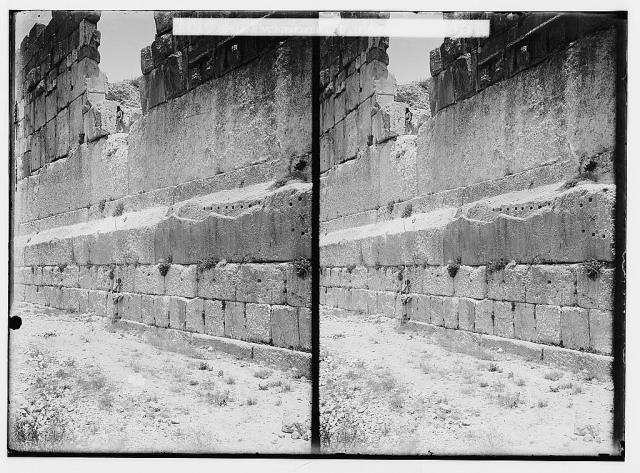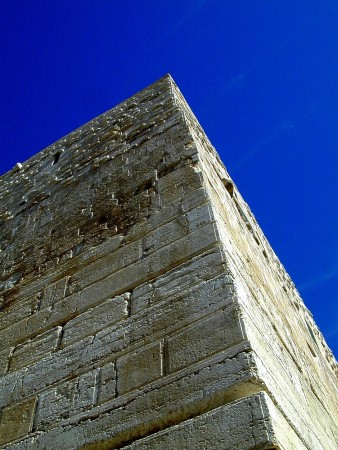Here’s a photo that sort of jumped out at me a while back, it was so striking: a great quarry stone at the ancient site of Baalbek in Lebanon. Look at the people, look at the scale! This stone, which was never fully detached from the bedrock, weighs in at something like 1,000 tons! (By comparison, a fully-loaded 747 is on the order of 400 to 450 tons.) To me, it’s just astounding!

The Grand Quarry of Baalbek. (Scan from 2×2-in. color slide reproduction of a hand-tinted print; LOC/Matson image #22986.)
Baalbek is a town in Lebanon’s Beqqa Valley, about 53 miles northeast of Beirut. In Greek and Roman antiquity, it was known as Heliopolis, and today the site possesses some of the best-preserved Roman period ruins in Lebanon, including one of the largest temples anywhere in the Roman Empire. The gods that were worshiped there included Jupiter, Venus, and Bacchus.
Among the 22,000-plus images belonging to the Matson Collection of the U.S. Library of Congress, there are actually scores of American Colony pictures depicting Baalbek and its various monuments and ancient ruins. These images were the product of both the Colony’s early photo expeditions and, later, sightseeing tours conducted by Colony members for the benefit of visitors to the Holy Land. Indeed, in those days one could jump in a car and drive virtually anywhere–it was a different world!
The gigantic building stones of Baalbek, it is fair to say, are unique in the whole world. (When dealing with superlatives, one must be careful–at least I try to be.) The stone pictured above is part of what has been dubbed the “Grand Quarry”, which lies less than a mile distant (and uphill, of course!) from Baalbek’s central temple complex, where such stones were being used. Nearby in the same quarry, another stone–likewise unfinished and only discovered in recent decades–was found to be even bigger, estimated at 1,200 tons. Now, in 2014, yet a third quarry stone has been unearthed by German archaeologists beneath and to the side of the one pictured–it clocks in at 1,650 tons! Again, all of them were apparently left unfinished and still attached to the bedrock to one degree or another. Still, taken together, they rank high among the largest hewn monoliths in the world. Here are other American Colony views of the 1,000-ton stone:

The Grand Quarry of Baalbek, before ca. 1920. (Scan of original stereograph negative, source of the color version above; LOC/Matson image #01162)

Grand Quarry of Baalbek, ca. 1920-1933. (Scan of original negative; LOC/Matson image #15481)
But there’s more… Looking online, I found out about Baalbek’s “Trilithon”, a course of three other, 800-ton stones that were actually set in place, forming part of the western retaining wall of the Temple of Jupiter. These qualify as the largest man-made monoliths in the world that were ever moved and actually used in construction. (And, in the same complex there are about 24 other giant stones of some 300 tons each!) Not surprisingly, an American Colony photographer documented these Trilithon stones as well: In the photo below, they are the stones (only two are pictured) above the beveled course; a human figure is visible standing at the top of the vertical joint between the two stones, in the breach of the upper wall:

Baalbek “Trilithon”, before ca. 1920. (Scan of original stereograph; LOC/Matson image #01161.)

Baalbek “Trilithon”. Artist’s rendering showing the placement of the three stones. (found on-line)
As you might expect, the question of how these incredible stones were moved and handled has generated considerable discussion over the years–including ancient alien theories and all the rest. The best, most level-headed treatment I found (with photos & diagrams) was HERE. Short version: The stones (all of red granite) were never lifted at all. The key elements of the stones’ transport and placement: rollers were installed underneath during the quarrying process; the quarry lies slightly uphill from the building site about 1/2 mile away; about 400 workers and lots of time were required; the mechanics involved multiple capstans and block & tackle; final placement was made by sliding the stones into place.

Transporting the “Thunder Stone”, 18th cent.

St. Petersburg, Statue of Peter the Great

Ramat Shlomo Quarry, ca. 2009. My friend stands at one end of the “shadow” of a single, 20-plus-foot-long extracted stone. (Photo: Tom Powers)

Southwest corner of the Temple Mount (Photo: Todd Bolen, bibleplaces.com). Counting from the bottom, note how courses 2, 4, 6, etc. are very long stones running to the left; in between are the ends of similar stones, but running in the other direction.
This all reminded me of a visit I made several years ago to Ramat Shlomo, an Israeli settlement on the northern outskirts of East Jerusalem, where archaeologists had then just excavated a Herodian period quarry. It was a discovery that related directly to Temple Mount construction technology, as the extracted stones–their enormous size was known from the “shadow” left behind–were such that they really could scarcely have been used anywhere else.


